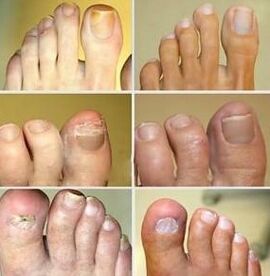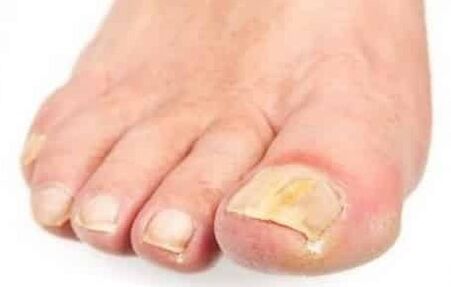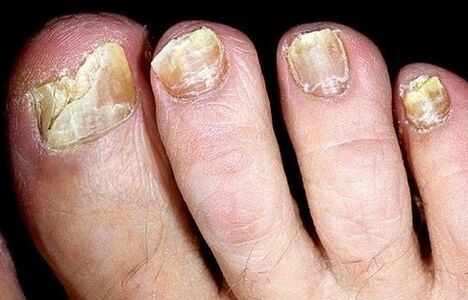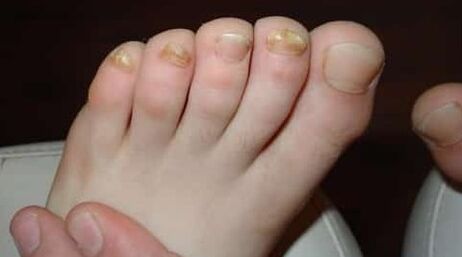Onychomycosis is a pathology that destroys the nail plates.The mushroom eats keratin - the building basis of the nail.The infection falls into the intercellular space and begins its division.In the advanced stages, pathology can influence the skin of the feet, the interal zone and paragraphs.

Causes of nail fungus
Infected with onychomycosis is pretty simple.The infection can lurk at the pool on the beach, in the public soul.A high probability of catching a fungus of infected relatives or acquaintances (using common life).
There are several main requirements that can provoke the penetration of the virus into the human body:
- A weak immune system - a decrease in the protective forces due to contagious or inflammatory diseases;
- Vascular pathologies (blockage of the veins) violations of the work of internal organs (diabetes) that lead to problems with the blood flow to the lower extremities;
- Minor damage to the skin on the feet (abrasions, microesses, grains, grains) that were caused by wearing close shoes;
- Ignoring diaper rash and intensive sweating of the lower extremities;
- Violation of the precautionary measures - trying on another, attempting to visit public places without slippers and neglect the hygiene of the legs.
Types of nail fungus
Onychomycosis can provoke different types of mushrooms.Dermatophytes appear, for example, in the form of clouding the nail.There is a formation of yellow spots along the edges or in the middle of the plate.In addition, longitudinal sections along the affected area can be observed.
The yeast mushroom provokes a deformation of the nail plate.It is very clever and begins to move away from her place becomes gray.The metabolism in injured cells worsens, furrows appear on the nail roller.In addition, inflammation, edema and redness appear on the adjacent epidermis, the disappearance of the cuticle is observed.
Mold mushroom bacteria can violate the nail plate if there are already diseases that cause nail nutritional disorders.In this case there is also a cloudy of the plate, a change in its color (from light yellow and greenish to brown and even black).
In order to find out the cause and the pathogens of negative changes in skin and nails, you must contact a specialist.An independent determination of the disease and its treatment without consulting a doctor can be affected with consequences.
Disease stages

The mycosis of nails gradually affects healthy cells.The disease has several stages of development, each of which has its own specific manifestations.
The first stage of onychomycosis (normotorophytically) has no light manifestations.In most cases it is hidden.The first characters - the nail fades a little, its color changes, microbrises and yellow spots are formed in the form of circles or queues, and tuberosity occurs.A beginner mushroom can be accompanied by itching and burning.It is difficult to recognize the infection in the early stages correctly, since the symptoms are similar to other diseases (psoriasis, liver pathology).
If treatment does not begin over time, the disease goes into the next stage - hypertrophic.The nail is thickened, dark.There is a deformation of the plates, its crowning and destruction.
The advanced form of nail disease is shown by a strong thinning of the nail plate, which leads to its further rejection.The adjacent skin becomes blue, an unpleasant smell appears.
Symptoms
Onychomycosis most often affects the nails on the legs, the hands suffer less often.The disease begins with the thumb and the little finger (the outer edge is touched) and affects all the panels smoothly.
The leading symptoms of onychomycosis help to determine the fungal infection:
- The appearance of stripes and stains of a whitish or greenish color under the nails;
- Topping of the plate, a change in its color (from yellow to dark brown);
- Reding and peeling the skin around the nail;
- The appearance of roughness on the feet and between the fingers;
- The formation of mold on the nails.
Types of mushroom diseases of the nails
Onychomycosis is usually classified by the appearance of the affected areas.Since the classification feature of the mushroom looks on the nails, it differs in three types, depending on clinical manifestations:
- Atrophic or onholytic - in which the nail plate is significantly influenced, up to the degree of rejection from the nail bed;
- The hypertrophic appearance in which the natural shine has lost, changes its color (white or vice versa) and the structure (more tangible) with the appearance of different types of deformations and even destroys along the edges;
- Normotrophic - a type that is characterized by the lowest degree of damage in which the nail plate is not thickened remains brilliant and smooth, but still externally changes due to the occurrence of stains, stripes and other visible changes in its natural transparency and color.

Abroad there is another classification according to which the mushroom is divided into species on the nails on the nails depending on the specific location of the lesion:
- Total, in which the entire nail plate is covered by a pathogenic process;
- Distal - the shape of damage that only localized on the free edge of the nail that protrudes above the fingertip;
- proximal in which the edge of the plate is destroyed under the nail roller (opposite the free edge of the nail!);
- The lateral damage that affects the side pages of the nail plate.
What the pathology looks like
The mushroom nail diseases between the population are similar to other dermatological diseases of Negribian nature.Depending on the phase of pathology, the nails look unhealthy because they lose natural shine and transparency.Of the smooth and even and evenly, they are thick and deformed and are covered with different colors (often white or dirty yellow).The soft tissue destroyed by a parasite, which surround the keratin layer, are also involved in inflammatory reactions, swollen and ulcers.
If we look at the image of the destruction of the nail plate in the perspective of the dynamics of the disease, it can be divided into three consecutive stages:
- There are practically no signs in the first stage, except for slight mattness, dots or stripes on the plate.
- On the so -called a pronounced stage that quickly replaces the initial, all symptoms of onychomycosis are obvious.
- The advanced level is the ultimate degeneration of the nail and can be supplemented by the occurrence of an unpleasant smell of dilapidated tissues.
The reasons for the deformation of the nail
Mold, yeast -like mushrooms and dermatophytic fungi cause infectious diseases of the nails (onychomycosis), which manifest themselves with similar symptoms.All types of mushrooms of nails on the legs or arms deform the nail plate, change their transparency, shine, color.Changes in the nail are determined not only in onychomycosis, but also in injuries, chronic paronichia (inflammation of the nail roller), psoriasis, handicops, dermatitis.Before you draw a conclusion via fungal infections, you must take all possible options into account.
Symptoms of mushroom
There are different classifications of nail fungus, depending on the type and manifestation, you can have completely different signs and symptoms.It is therefore very important to determine them (psoriasis, eczema, stray lichen and dermatophytes).The superficial onychomycosis on the fingers manifests itself almost immediately after the infection.Consider the symptoms and signs of mushrooms on the nails of the legs and arms:
- Thickened plate;
- Broken, crumbly or torn nails not only near the edge, but also on the surface;
- Distorted shapes, scaly structure;
- The initial stages is the loss of brilliance and elasticity;
- If the nail is blackened (not in the case in the case if a person works regularly with coloring compositions or mechanical parts);
- Nails fall under the skin;
- Dysbacteriosis begins, possibly a general decline in immunity, strength, drowsiness;
- The itching between the fingers and on the foot is particularly pronounced in the child;
- The examination from the nail bed is a very common phenomenon and almost the last stage before the full nail loss, which is called an onycholisis.You can feel pain in your fingers and find a somewhat unpleasant smell.
- The skin becomes dry, cracks, a rash appears, possibly even the appearance of blood or a soucon;
- A shape white or yellow circle under the nail, depending on the diversity of the mushroom, it can be bright, dull, with outlined edges and a muddy structure.

Before you start active actions, the negative effects of the external environment must be minimized to eliminateThe reasons why the mushroom appearedUnder the nails on the legs:
- A warm and moist environment is ideal for the growth of various microorganisms.Try to dry shoes constantly after walking, only wearing socks from natural materials that offer normal heat and air exchange.
- The athlete's foot often appears due to poor immunity.You can simply step on the floor with your bare foot and pick up the infection and take vitamins to avoid this.
- Frequent nail extension can become one of the causes of onychomycosis that limit the procedures to 1 session in six months.
- The most complicated is the likeable - this is a fungus caused by active disputes.They penetrate into the hollows between nails and fingers, can be in a sleeping level for some time and then grow sharply.Most of the time they are infected in public use (pools, showers, solariums), while operating the shoes of other people, etc.
Frequent types of mycosis of the stop
There are many ways to get an infection with a mushroom of the legs, but it is only possible with direct contact with the pathogen.Most of the time, this happens while using other people's shoes or in violation of personal hygiene rules.The skin fungus on the legs usually manifests itself by destroying the dermis, which is reflected in the form of peeling.The lesions of the epidermis in this case are caused by the fact that the infection penetrates into the deep layers of the skin and destroys its structure.
Modern medicine identifies the following options for the mushroom damage on the feet, each of which distinguishes their symptoms and treatment options:
- Intodallic mycosis is the most common form in the form in which the disease manifests itself.The symptom is usually located between 3 and 4 fingers, less often between 4 and 5, it looks like a crack covered with a white film.It is possible to deduct a certain amount of liquid, peeling the limits and the occurrence of signs of diaper rash.Signs of an interdigital fungus of the legs can be accompanied by weak itching.Such a mushroom on the fingers of the legs can initially occur completely without symptoms, but in the future the skin structure will change significantly.
- The mushroom of squamous hyperkeratotic can be distinguished from other species by severe peeling and keratiization that influence the epidermis.It is characteristic of people who suffer from dermatitis in different ways, mainly atopic.This is a different kind of illness that can be seen clearly which mushrooms are on the legs.The main symptom of the disease is the appearance of an erytheme, a painful pink knot, on an affected area that has clear limits.It is accompanied by weak itching, cracks on the feet, dryness, pain, yellow and damage to the nail plates.Onychomycosis, which usually accompanies this type of fungus, leads to a layering of nails;
- The vesicular mushroom is one of the rarest types of infections that affect the skin of the legs.The disease received its name for the formation of vesiculas - blisters with liquid content, on which the erosion is formed, which is dangerous for the infection.The main signs that the mushroom vesiculosis varies: the appearance of blisters with a diameter of up to 1 centimeter and weak itching;
- Deleted mushroom.In the initial phase there is a slight peeling on the feet of the legs and the appearance of small cracks, which only influence the top layer of the epidermis.
- The fungus is dyshidrotic, the infection of which only occurs in medical practice in 8% of the patients infected with mycosis.It is mainly localized on the sole and the vault of the foot, manifests itself in the form of bubbles and gradually melts into a that his gap occurs on the formation of comprehensive erosion.The risk of a mushroom of this type is to combine a bacterial infection, since pathogenic microorganisms easily penetrate through the resulting wound;
- Intermician mycosis not only occurs independently, but also as an accompaniment of a squamous epithelial form of the mushroom of the legs.It manifests itself between the fingers of the feet, characterized by severe itching and burning, diaper rash and the appearance of erosion;
- Onychomycosis is another frequent option of damage that is a mushroom of nails on the legs.It usually develops from the free edge of the nail plate.The initial stage is characterized by the appearance of yellow spots, according to which the disease progresses with relaxation and the full vacation of the nail.It often accompanies other forms of mushroom lesions;
- The candidal mushroom, also called yeast erosion, which is located in the interdigital space.In this case, the mushroom looks like the concentration of inflamed swollen skin areas, which can be surrounded by pustules of small shape.



















